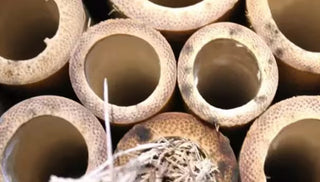
Orchard mason bees are small bees native to North America and are very good pollinators for flowers and fruit trees. They visit as many a 1,000 blooms per day.
Mason bees do not use hives like honeybees. In nature, mason bees place their eggs in holes drilled by beetles or woodpeckers. The bees will also use spaces between roof shingles or other narrow openings around the garden.
The Mason Bee House is a bundle of bamboo tubes that provide a place for mason bees to reproduce and gather pollen and nectar for their young. After laying eggs, the adults die, leaving a new generation to take over.
Mounting the Bee House
The Bee House should be placed against a flat surface and located in an area protected from high winds. The front of the house should have a south or southwest exposure where it will get the most sun in winter to keep bees warm.
After bees mate, the female places eggs in the bamboo tubes. Each egg is separated by nectar and pollen?it is at this time that the bees? pollen-gathering also pollinates plants.
After the pollen and nectar is placed, the female places a mud plug in the tube (hence the term ?mason?), then repeats the process with more eggs, pollen, nectar and plugs. When the tube is full, she finishes with a heavy mud plug and her work is done.
In the spring, the mature bees emerge from the tubes. Males exit first. Females emerge after males because the eggs are placed deeper in the tubes. This is a protective measure, assuring a good female population to help keep the species going.





